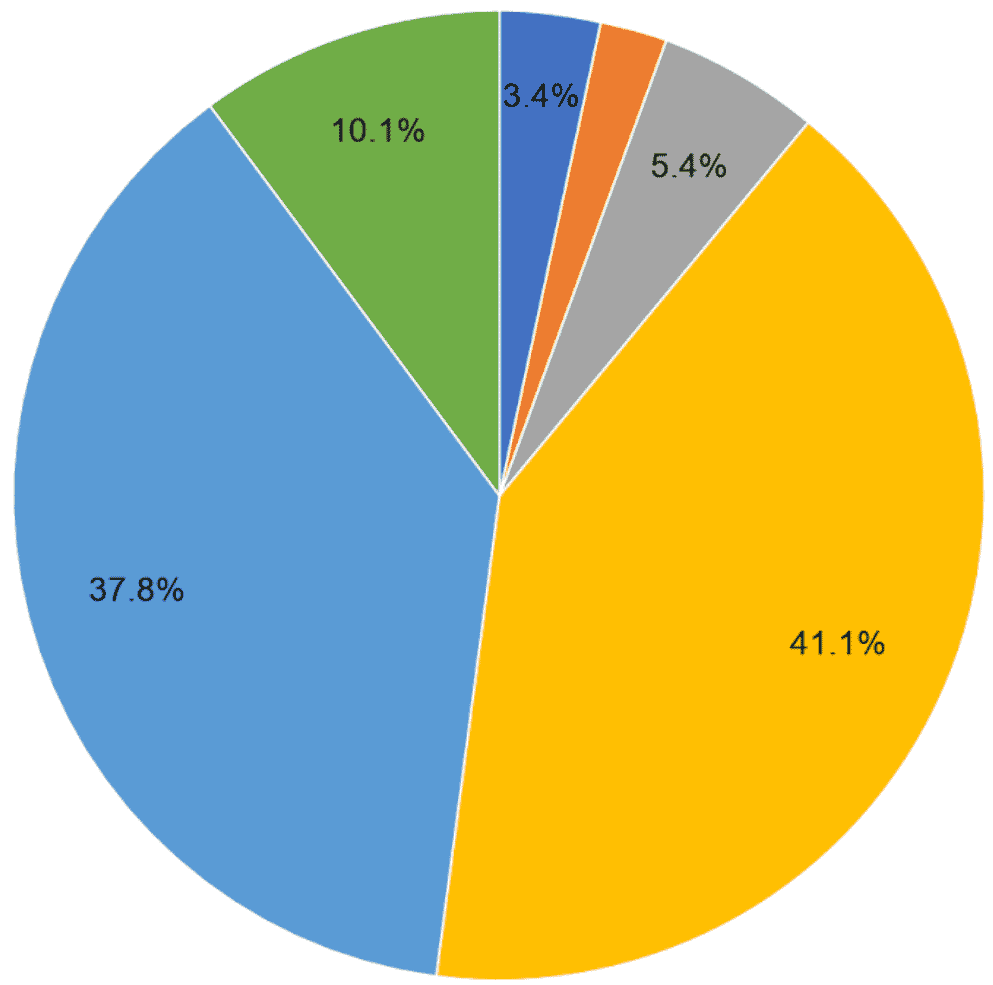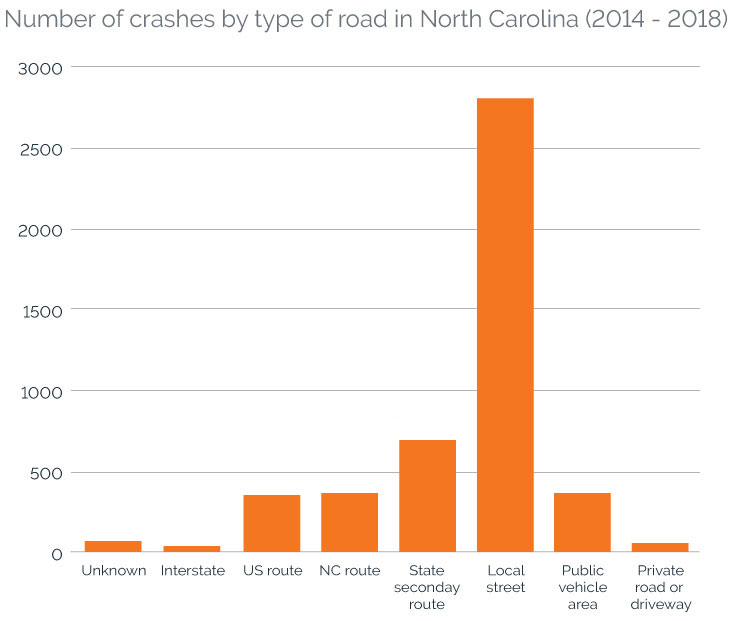Establishing liability might be the key to recovering costs for your bike accident in the Tar Heel State.
When you think about it, a bicycle is a pretty miraculous invention. It’s a simple contraption that provides cost-effective transportation, exercise, recreation, and is environmentally friendly. Other than your own feet, there aren’t too many other ways to get from place to place that cover all of these bases.
Because Americans are more conscious today than ever before about our health and the environment, more of us are riding bikes as a regular part of our daily lives. However, some of our roads and infrastructure weren’t designed for bikes and cars to share the road safely — and some drivers don’t take bicyclists into consideration.
Common causes of bike accidents in North Carolina
Many bike accidents can be prevented by the rider. A rider can’t control a motor vehicle driver’s behavior, but you can avoid some of the common ways that bicyclists get injured.
1. Distracted driving/bicycling
You’ve probably heard plenty of public awareness campaigns about texting and driving or other forms of distracted driving. But distracted biking is an issue, too. Many cyclists look at their phones or other devices while riding, and that’s always dangerous. Your eyes and attention need to be on the road at all times, whether you’re biking or driving.
2. Speeding
Like drivers, a cyclist should ride in a way that allows them to be in control of their bike at all times. Your speed should depend on road conditions, weather, amount of travel, speed of vehicle traffic, and other factors.
3. Riding too close to traffic
Twenty-six states and the District of Columbia require that a motorist give bicyclists at least 3 feet of space when passing. North Carolina doesn’t currently have a safe passing law. However, a safe practice is for a driver to allow 3 feet of clearance between the vehicle and the bike, whether it’s the law or not.
4. Intersections and lane merges
Bicyclists should follow the road rules just like motorists. Intersections, lane merges, and other situations where cars are turning or traveling outside of a single lane can be dangerous. It’s important for cyclists to be aware of not only where they’re going, but what the motorists around them are doing, too.
5. Sidewalks, parking lots and driveways
Some drivers (and bicyclists) think that because cars tend to move more slowly in parking lots or when backing in or out of a driveway, those areas aren’t dangerous. But because these scenarios often involve backing up and unexpected movement, they can present risks.
North Carolina bicycle accident statistics
WalkBikeNC, a department of the North Carolina Department of Transportation that promotes walking and biking in the state, reports that in 2014 (the most recent year for reported data), there were 19 bicyclists and 162 pedestrians killed in accidents with motor vehicles.
Nationwide, North Carolina is ranked 41st when it comes to the number of bicycle commuters. However, some communities — like Carrboro, NC — are making efforts to better connect walking and bicycle networks. Approximately 5% of Carrboro commuters use bicycle transportation, which is one of the highest rates in the country.
There were 4,700 bicycle crashes in North Carolina from 2007-2011. That makes it the 7th most dangerous state for bicycling, according to the Alliance for Bicycling and Walking.
Not every crash results in a fatality. Based on the data from 2014-2018, more than half of bicycle crashes resulted in minor injuries or no injury at all. However, the majority of crashes involved people in their 50s, and the vast majority took place on local roads.
Take a look:
Percent of total bicyclist crashes in north Carolina (2014-2018)
| Injury severity unknown | |
| Killed | |
| Suspected serious injury | |
| Suspected minor injury | |
| Possible injury | |
| Not injured |

| Top 10 types of bike crashes in North Carolina (2018) | Number of crashes | |
|---|---|---|
| 1 | Motorist overtaking - other / unknown | 585 |
| 2 | Motorist drive out - sign-controlled intersection | 370 |
| 3 | Motorist left turn - opposite direction | 355 |
| 4 | Motorist drive out - commercial driveway / alley | 334 |
| 5 | Non-roadway | 222 |
| 6 | Bicyclist ride through - signalized intersection | 204 |
| 7 | Bicyclist ride through - sign-controlled intersection | 203 |
| 8 | Motorist right turn - same direction | 202 |
| 9 | Motorist overtaking - undetected bicyclist | 196 |
| 10 | Bicyclist left turn - same direction | 140 |
| Source: NC Department of Transportation | ||
North Carolina bike accident liability
North Carolina is one of a very few states that uses a pure contributory negligence standard. This means a plaintiff in a personal injury claim (the injured person) cannot recover damages if they were at all liable for the accident.
In many states, a plaintiff can recover damages even if they could or should have done something differently that would have avoided the accident. In those situations, the court would look at the evidence and determine each party’s percentage of liability.
For example, if a driver caused an accident with a bicyclist because the driver rolled through a stop sign, then the driver is clearly liable. But if the bicyclist was riding and texting, they might be determined to be 20% liable because they should have been paying better attention. If they had, they might have been able to avoid being hit. In that situation (for many states), the bicyclist’s damage recovery would be reduced by 20% to account for their liability.
But not in North Carolina.
If the court finds that you’re even 1% liable for a personal injury accident, you can’t recover any damages. That’s why it’s especially important that everyone in North Carolina who rides a bike is aware of bike laws — not just for safety, but also to make a successful legal claim.
North Carolina bike laws
BikeWalk NC says:
“North Carolina traffic laws treat bicycles as vehicles and treat bicyclists as drivers of vehicles.”
Here are some of the most important North Carolina laws regarding bicyclists and drivers:
- Bicyclists as drivers. Because North Carolina considers a bicyclist to be a driver, bicyclists are allowed to travel on all public roadways except for fully controlled access highways like an interstate.
- Nighttime lights. A bicycle must have the following lights when riding at night:
- Reflex mirror on rear
- Lighted lamp on front, visible from at least 300 feet
- Lamp on rear with red light visible from at least 300 feet or biker must wear clothes bright enough to be visible from at least 300 feet behind the bike
- Duty to limit speed. A driver of a car or a bicyclist is required to travel at a speed that’s “reasonable and prudent” under the existing conditions. Even if you’re traveling at a speed lower than the posted speed limit, you’re still required to decrease speed as necessary to avoid injuring a person or property.
- Drive on the right side of the road. You must ride on the right-hand side unless:
- You must overtake and pass another vehicle
- An obstruction requires you to move to the left
- A highway is divided into three marked lanes
- The road is designated for one-way traffic
- Stop/yield before entering a bigger roadway. Put simply, follow road signs and signals.
- Yield before changing lanes.
- Destination positioning during turns. If you’re turning right, stay as close to the right as possible. If turning left, make the turn by staying toward the rightmost section of the lane.
- Bicycling while impaired. Just like driving while impaired by alcohol or drugs, bicycling under the influence of alcohol or drugs is also prohibited.
- Children under 16 must wear a helmet. A child under the age of 16 must wear a helmet while riding a bicycle.
- Bicyclists using hand and arm signals. A bicyclist is required to use established arm signals to alert drivers of intent to stop or turn.
There might also be local laws or ordinances where you ride, so be sure to learn what the requirements or restrictions are in your community. Know before you go!
Bike accident injuries and damages
If you’re involved in a North Carolina bike accident, there are steps you can take to preserve your legal claim. First, get the medical treatment you need. Your physical well-being after an accident is always first priority.
If you’ve been injured, you’re entitled to recover costs for:
- Medical treatment
- Lost wages
- Property damage or loss
- Pain and suffering or other emotional distress
- Funeral and burial expenses if the accident resulted in wrongful death of a family member
- Other costs related to the accident
What to do after a bike accident in North Carolina
If you’re able to do so, take these steps after a bike accident:
- Call 911. A police report is an important piece of evidence. Even if your injuries are minor (or you feel uninjured), you’re entitled to (and should get) a police report at the scene.
- Obtain information from the driver. Just like you would after any motor vehicle accident, obtain the driver’s name, address, phone number, email, insurance information, license plate number, and driver’s license number. If you have your phone with you, it’s a good idea to take photos of these documents.
- Obtain witness information. Any person who observed any part of the accident (including events leading up to it or following) can be valuable as a witness. Be sure to write down these people’s names and contact information.
Accident Report Form
Sample post-accident report form to keep in your glove box - fill out at the scene or as soon as you can after a car accident
Download in PDF format - Take note of the conditions at the scene. Weather, road conditions, traffic patterns, signals, and other things could all be factors in a bike accident. The police report should include some of this information, but you should take your own notes, too.
Post-Accident Journal Form
Sample accident journal/diary to help you document the effect on your daily life
Download in PDF format - Get a medical examination. Whether you think you’re injured or not, go to a hospital, your primary physician, or an urgent care center for a medical exam. Some symptoms might not appear until days or weeks after an accident. Full documentation by a medical provider can be crucial to your legal claim. If your condition isn’t documented, it can be hard to prove that your injuries were caused by the bike accident.
- Call a North Carolina bike accident lawyer. Because North Carolina doesn’t award damages if a plaintiff had any liability in an accident, the driver might try to claim that the collision was completely or partially your fault. That’s where your lawyer becomes important. A bike accident lawyer is trained and experienced in helping you avoid liability and recover damages.
See our guide Choosing a personal injury attorney.





